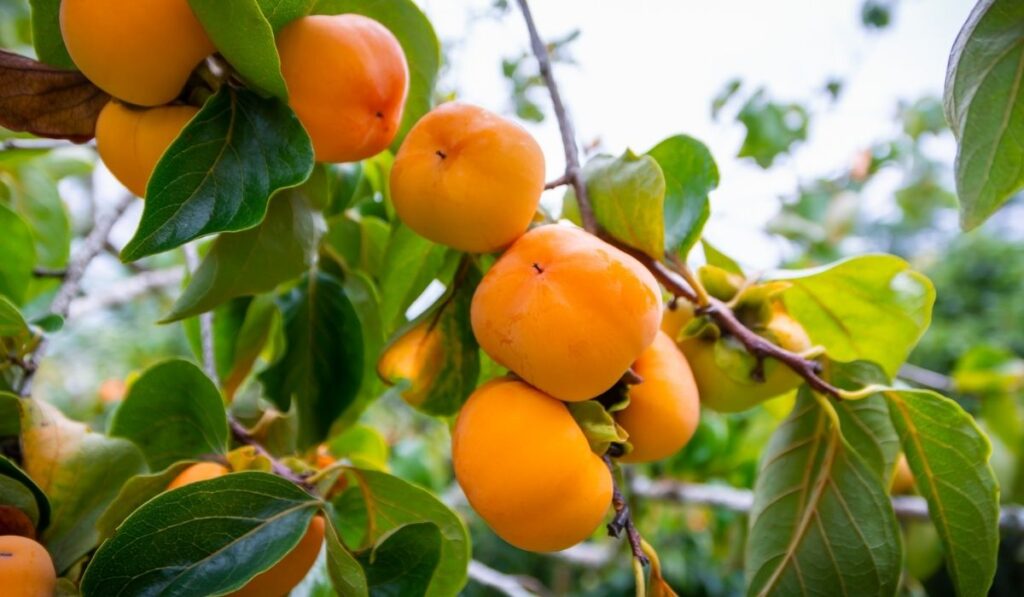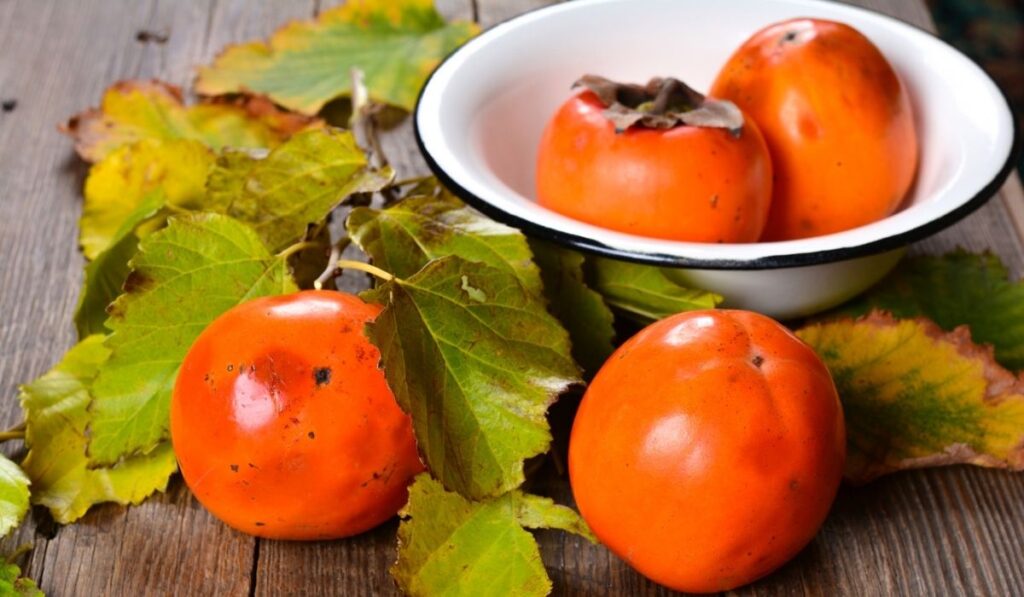The persimmon fruit is a small, round fruit that grows on the deciduous tree of the same name. Persimmons are generally orange or red and have soft, sweet flesh. The flavor of the fruit has been described as similar to a cross between the flavors of a plum and an apricot. In the United States, persimmons are grown in the states of California, Florida, and Texas.
Fresh persimmons are available in the fall and winter months. When buying persimmons, look for fruits that are free of blemishes and have smooth skin. There are two main types in the US: Fuyu persimmons, which have a sweeter taste, and Hachiya persimmons, which can be very astringent if not ripe.
Those are the basics, but there’s a lot more to know about persimmons before you head to the market to find some of your own. Let’s look at the best time to buy persimmons, how to eat them, and why they’re known to sometimes cause cottonmouth.
When Are Persimmons in Season?

Persimmons are typically in season in the United States from October through February. However, the exact time will depend on the type of persimmon and where it’s grown. For example, Fuyu persimmons are available earlier in the season than Hachiya persimmons.
Persimmons are native to China but are now also grown in California, Florida, and Texas. Persimmons are available at many supermarkets and farmer’s markets.
Even out of season, people sometimes buy and store shelf-stable dried persimmon slices (on Amazon) that can be used as an ingredient or eaten directly.
Health Benefits of Persimmons
Persimmons are a good source of fiber and vitamins A and C. They contain some other compounds that may also have health benefits. For example, persimmons contain tannins, which have antiviral and antibacterial properties.
Tannins may also help to protect the body against cancer. Additionally, the antioxidants in persimmons may help reduce inflammation and boost the immune system.
While more research is needed to confirm the health benefits of persimmons, there’s no doubt that this unique fruit is a delicious and nutritious addition to any diet. So, if you see some persimmons at your local grocery store, be sure to give them a try!
How Do You Eat Persimmons?
Assuming your Hachiya persimmon is ripe, there are a few ways you can enjoy this unique fruit. One popular way to eat a Hachiya persimmon is to simply cut it in half and scoop out the flesh with a spoon.
This method allows you to avoid the astringent taste of an unripe persimmon. You can also eat Hachiya persimmons whole, skin and all. Just be sure to remove the stem first.
Some people like to add Hachiya persimmons to salads, while others enjoy them as part of a holiday fruitcake or pudding recipe.
Fuyu persimmons can be eaten like apples. Just wash the fruit and enjoy. You can also cut Fuyu persimmons in half and scoop out the flesh with a spoon.
This fruit is often added to salads or used to decorate holiday dishes. Whether you eat them whole or halved, Hachiya and Fuyu persimmons make a delicious and healthy snack. But be sure to enjoy them while they’re in season!
Some people find that eating persimmons can cause an itchy feeling in their mouths. This is due to the high concentration of tannins in the fruit. If you experience this itchiness, try eating the fruit with some yogurt or milk, as this can help to neutralize the tannins.
What Is the Difference Between Hachiya and Fuyu Persimmon?
If you’re lucky enough to come across a persimmon at your local grocery store, you’ll want to know the difference between Hachiya and a Fuyu persimmon. While they may look similar at first glance, there are some pretty big difference to keep in mind.
For starters, Hachiya persimmons are much larger than Fuyu persimmons. They also have a more oblong shape, while Fuyu persimmons are more round. The biggest difference, however, is in their taste.
Hachiya persimmons are incredibly astringent when they’re not ripe. This means that they’ll make your mouth feel dry and pucker up. You’ll probably be pretty disappointed if you try to eat a Hachiya persimmon that isn’t ripe.
On the other hand, Fuyu persimmons are non-astringent, which means they can be eaten even when they’re not quite ripe. They also have a sweeter taste than Hachiya persimmons.
So, which one should you buy? If you’re looking for a sweet snack, go for a Fuyu persimmon. If you’re looking for something to bake with or use in a savory dish, go for a Hachiya persimmon. Just make sure that it’s ripe!
Why Do Persimmons Give You Cottonmouth?

The tannins in persimmons can cause cottonmouth, which is a dry feeling in the mouth. That’s why it’s essential to let a Hachiya persimmon ripen until it’s soft before eating it.
By the time it’s soft, the tannins will have broken down, and the astringent flavor will disappear. If you do experience cottonmouth after eating a persimmon, drinking lots of fluids should help relieve the symptoms.
If you’re plagued with painful puckering after eating persimmons, there are a few things you can do to prevent it in the future:
- Pick the right variety: If you’re sensitive to tannins, opt for Fuyu persimmons instead of Hachiya. Fuyus are lower in tannins and can be eaten when firm, like an apple.
- Wait for ripeness: Allow Hachiya persimmons to soften until they’re almost mushy before eating. This will give the tannins time to break down, making them less astringent.
- Pair with other foods: Eat astringent fruits and vegetables alongside milder ones to balance out the flavors. For instance, pair a Hachiya with some yogurt or cheese.
- Drink plenty of fluids: Drinking water or another beverage after eating a persimmon can help wash away any tannins left in your mouth. This will also help to keep you hydrated.
